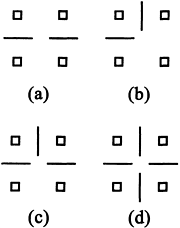164.
| [Cover] [Contents] [Index] |
Page 245
(6.19) indicates that if an edge does not exist (Err′=0) between adjacent pixel r and r′, the smooth interaction coefficient β behaves as normal; otherwise, one should mark the presence of edge and deal with the edge potential VErr′. The simplest form of edge potential VErr′ is set as a constant VErr′=λ (>0), where λ should be smaller than β.
The idea can be developed further by noting that if a possible edge is detected (i.e. wr wr′), we would like to pay out less energy (i.e. λ instead of β) in order to ‘bargain’ more probability for its presence. More complicated ways of defining the edge potential VErr′ are possible (Geman and Geman, 1984; Koch, 1988; Li, 1990). The discontinuity concept relating to image restoration is addressed in Section 6.2.3.
wr′), we would like to pay out less energy (i.e. λ instead of β) in order to ‘bargain’ more probability for its presence. More complicated ways of defining the edge potential VErr′ are possible (Geman and Geman, 1984; Koch, 1988; Li, 1990). The discontinuity concept relating to image restoration is addressed in Section 6.2.3.
Sometimes the resulting edge patterns are not always reasonable. In other words, based on our realisation of natural patterns, some edge patterns are less likely than others. Figure 6.8 shows examples for specifying possible edge patterns over the four neighbourhood systems within which only horizontal and vertical lines are considered. We also make a rotation-invariant assumption. In Figures 6.8c and d, the edge pattern is more unreasonable (or less likely). A straightforward way to eliminate these unlikely edge patterns is to add a ‘forbidden edge potential function’ Vf into Equation (6.19). We can assign a sufficiently large constant (→ ∞) to Vf, which is active only under the circumstance that a ‘forbidden’ edge pattern has resulted. For example, one may define Vf as:
 |
(6.20) |
to prevent a triple and quadruple junction, where λf (>0) is a sufficiently

Figure 6.8 Some possible edge patterns over a four-neighborhood system. Pattern (a) continuation; (b) turn; (c) triple junction; and (d) quadruple junction.
| [Cover] [Contents] [Index] |
EAN: 2147483647
Pages: 354